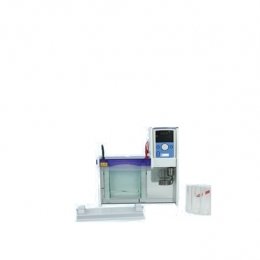Feaures:
Denaturing Gradient Gel Electrophoresis (DGGE) is an important technique used in the search for mutations and DNA polymorphisms critical in genetic disorders and cancers, and to understand genetic diversity among species. The new VERTICAL ACV20WAVE-DGGE is a flexible and customisable system that can perform several different mutation detection
Techniques.
The ACV20WAVE-DGGE – a versatile single-unit solution for differentsingle-base pair mutation detection methods The newly designed ACV20WAVE-DGGE is a complete system for DNA mutation analysis. Using the innovative vertical screw-clamp technology of the new ACV20-WAVE system
the ACV20WAVE-DGGE is fully equipped – with temperature control unit, stirrer, and gradient mixer and casting accessories – to perform specific mutation analysis applications. A powerful microprocessor-controlled PID temperature control unit enables various mutation detection techniques to be undertaken between ambient temperature and 70°C, while the simple fourscrew design of the WAVE insert accelerates set up of denaturing PAGE gels. Accordingly, the new ACV20-DGGE can be used to screen single-base pair changes in the following
applications:
• Heteroduplex analysis (HA)
• Parallel Denaturing Gradient Gel Electrophoresis (DGGE)
• Constant Denaturing Gradient Gel Electrophoresis (CDGE)
The flexibility provided by the modular design of the ACV20WAVE-DGGE and its wide range of accessories enables laboratories to switch quickly and easily between different mutation detection techniques, thereby maximising throughput and screening efficiency. A maximum 96-sample throughput allows detection of as many mutations within a couple hours, alleviating many of the bottlenecks associated with screening for DNA mutations.
GM100 Gradient Mixer ensures efficient gradient formation The GM100 gradient mixer is supplied as standard to ensure efficient gradient formation by mixing and delivering high- and low-density denaturant solutions. A flat-base design and support handle allows the GM100 to be secured to a retort stand, enabling it to be easily mounted on a magnetic stirring plate while the mixing chamber can accommodate a magnetic stirrer to form a linear gradient. The MU-D01 peristaltic pump is also recommended for delivery of linear and reproducible gradient gels. Innovative Casting and Set-up Mechanism
The ACV20WAVE-DGGE utilises novel vertical screw clamp technology to assemble two vertical gels. This reduces the number of screws required for set up making casting assembly faster, while a built-in inner buffer chamber within the PAGE insert allows set-up to be completed without the inclusion of heavy top tanks or buffer chambers. A dual purpose PAGE insert eliminates the need for plate transfer, and is used with a cam casting base to guarantee efficient
leak free casting. Utilises the same combs and accessories as standard ACV20 systems
The ACV20WAVE-DGGE can use all of the combs, glass plates and accessories of existing ACV20 units, providing full flexibility. Two 1mm 24-sample combs are supplied as standard whileoptional 48-sample combs allow screening to take place directly from 96-well thermal cycler blocks after PCR® amplification. Precise thermal control The redesigned ACV20DGGE-TC temperature control unit combines buffer recirculation with
a heat sensor and 1.4kW heating element to facilitate precise temperature control to within ±0.02°C, allowing the gel temperature to be set to the melting temperature (Tm) of the amplified DNA polymorphism or mutation of interest. Other benefits include: a conspicuous 4-digit 16mm LED panel to aid set-up; precise tuning to within 0.1°C resolution; an operating set point, plus three adjustable pre-set temperature values; and stirred buffer circulation for temperature stability and uniformity. Programmable power supply option
At 500V, 800mA and 300W outputs, the optional AC-500V power supply provides full flexibility for different mutation detection techniques Software options: There are three software options:
• Pre-electrophoresis: mutations are best detected when the single-base pair mutation itself is located within lowest melting domain of the DNA of interest, and the molecule does not denature entirely. GC-clamping at one end of the DNA molecule ensures that the region to be screened is in the lower melting temperature domain while the DNA molecule remains
partly double-stranded. Recommended free POLAND analysis software (G Steger, University of Dusseldorf) predicts the melting behaviour of the DNA fragment of interest and resulting primer placement and GC clamp positioning.
• Post electrophoresis: Phoretix 1D is available for band pattern matching following parallel DGGE in a single gel; Phoretix 1D Pro allows comparison between multiple gels and different experiments
ordering information:
|
ACV20WAVE-DGGE |
Complete Denaturing Gradient Gel Electrophoresis System, 20x20cm; include: temperature control unit, cam castingbase, glass plates with 1mm bonded spacers,2x 24-sample combs and gradient mixer -240 VAC version |
|
ACV20WAVE-DGGE$ |
Complete Denaturing Gradient Gel Electrophoresis System, 20x20cm; include: temperature control unit, cam castingbase, glass plates with 1mm bonded spacers,2x 24-sample combs and gradient mixer -100 VAC version |
|
ACV20WAVE-DGGETC |
ACV20WAVE-DGGE Temperature Control Unit - 240VAC version |
|
ACV20WAVE-DGGE$ |
Complete Denaturing Gradient Gel Electrophoresis System, 20x20cm; include: temperature control unit, cam castingbase, glass plates with 1mm bonded spacers,2x 24-sample combs and gradient mixer -115 VAC version |
|
ACV20WAVE-DGGETC$ |
ACV20WAVE-DGGE Temperature Control Unit - 115VAC version |
|
ACV20WAVE-DGGEKIT |
ACV20WAVE PACKAGE DEAL: INC. ACV20WAVE-DGGE, AC-STIR, MU-D01, MU-S16, AC-500V - 240V |
|
ACV20WAVE-DGGEKIT$ |
ACV20WAVE PACKAGE DEAL: INC. ACV20WAVE-DGGE, AC-STIR, MU-D01, MU-S16, AC-500V - 100V |
|
Use ACV20 accessories |
|

